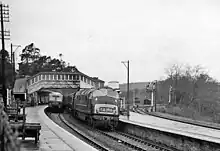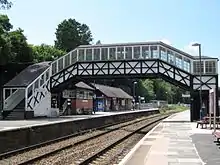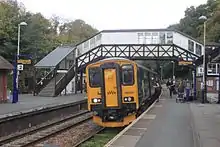Bodmin Parkway Fordh Bosvena | |
|---|---|
 Bodmin Parkway, looking east | |
| General information | |
| Location | St Winnow, Cornwall England |
| Coordinates | 50°26′45″N 4°39′47″W / 50.4458°N 4.6630°W |
| Grid reference | SX110640 |
| Managed by | Great Western Railway |
| Platforms | 3 (2 National Rail) (1 Bodmin & Wenford) |
| Other information | |
| Station code | BOD |
| Classification | DfT category D |
| History | |
| Original company | Cornwall Railway |
| Pre-grouping | Great Western Railway |
| Post-grouping | Great Western Railway |
| Key dates | |
| 1859 | opened as Bodmin Road |
| 4 November 1983 | renamed Bodmin Parkway |
| Passengers | |
| 2018/19 | |
| 2019/20 | |
| 2020/21 | |
| 2021/22 | |
| 2022/23 | |
| Notes | |
Passenger statistics from the Office of Rail and Road | |
Bodmin Parkway railway station (Cornish: Fordh Bosvena)[1] is on the Cornish Main Line that serves the nearby town of Bodmin and other parts of mid-Cornwall, England. It is situated 3 miles (4.8 km) south-east of the town of Bodmin in the civil parish of St Winnow, 274 miles 3 chains (274.04 mi; 441.0 km) from London Paddington measured via Box and Plymouth Millbay.[2] Network Rail’s National Rail Timetable dated May 2023 records the distance from London Paddington to Bodmin Parkway as 252.50 miles.[3]
Great Western Railway manages the station and operates most of the train services, although CrossCountry operates some long-distance services. The Bodmin and Wenford Railway operates a heritage service on the branch to the town on certain days.
History
Drawings held by Network Rail[4] show that the Liskeard Contract section of Cornwall Railway’s Plymouth to Falmouth scheme, within which Bodmin Road Station was eventually situated, had reached the detailed design stage by June 1854. Original proposals to build a branch to Bodmin, then the most important town in Cornwall, failed as the company was unable to raise enough capital. Instead they opted for a station at a convenient point on their main line. The most suitable location lay within the Glynn Estate, but as their agreement with Charles Crespigny Vivian, the landowner, forbade the construction of a station within his grounds, protracted negotiations were necessary before a new agreement could be reached.[5] When the railway opened on 4 May 1859, all that could be reported was that: "No station has yet been erected for Bodmin, owing to the site not having been immediately determined upon. It will be either near to Glynn Bridge or "Respryn" Bridge and, until it is completed, the Bodmin traffic will be accommodated at a temporary wooden shed erected near the latter place."[6] Respryn was near the entrance to Lanhydrock House, the home of Thomas James Agar-Robartes, 1st Baron Robartes, a railway supporter.
The new station was finally ready to open on 27 June 1859 and was named 'Bodmin Road'. Because of its remote location, the station master was paid five pounds by the Post Office to carry out the duties of postmaster. He also received a special lodging allowance until a house could be provided for him two years later. A goods shed was built in 1860 at the east end of the station, behind the platform for trains to Plymouth, and cattle pens were added the following year. A footbridge across the line was built by Mr Robartes in 1860 to enable visitors to reach Lanhydrock more easily. This was later replaced by a passage beneath the tracks. This path is still used by those visitors to this National Trust property who arrive by train.
Proposals were made in 1863 for a Bodmin, Wadebridge and Cornwall Junction Railway to connect the Cornwall Railway at Bodmin Road with the Bodmin and Wadebridge Railway at Bodmin, an isolated standard gauge line owned by the London and South Western Railway. An agreement was reached in 1864 for the Cornwall Railway to work the line once it was completed, and an Act of Parliament was obtained. Capital proved difficult to raise and so the scheme failed. The line was eventually built by the Great Western Railway, opening on 27 May 1887. The branch line served the rear of the up (eastbound) platform which meant that the goods shed had to be moved from that area to the opposite end of the station. Lord Robarte's footbridge was also in the way so was replaced by a new path under the railway near the goods shed. The main building, which was on the down platform, was extended and a covered footbridge provided between the platforms. The branch was a standard gauge line and so traffic from Bodmin to the Cornwall Railway had to be transferred at Bodmin Road until the broad gauge line was converted over the weekend of 21 May 1892.[7][8]
The station was further rebuilt in 1896. The platform was lengthened and the goods yard enlarged goods yard were provided.[9][10]
The Cornwall Railway was originally a single track 7 ft (2,134 mm) broad gauge line, but a passing loop at Bodmin Road allowed trains to pass. The railway company was amalgamated into the Great Western Railway on 1 July 1889. After the route had been narrowed to 4 ft 8+1⁄2 in (1,435 mm) standard gauge in 1892 i work started to lay a second track. The second track westwards to Lostwithiel opened on 2 July 1893 and eastwards to Doublebois on 22 December 1893.[11]
The Great Western Railway was nationalised into British Railways from 1 January 1948.
In 1958, John Betjeman (who was the poet laureate from 1972 to 1984) wrote in a letter to his friend Peggy Thomas:[12]
Perhaps we could all set up at Bodmin Road Station by arrangement with the Great Western – you in the refreshment room because of drink, Lynam in the signal box because of administrative ability, me in the booking office because I’m literary, Edward [Hornby] to do the lamps and odd jobs because he’s so clever with his hands, Douglas to look after the down platform as head porter and Ted as outside boy, pushing trolleys to Bodmin and meeting motor cars on arrival. We won’t have a station master, as we’ll be one glorious Soviet. Joan [Kunzer] will run the Bodmin branch.

By 1963 fears were growing that British Railways Board (BRB) was considering closing Bodmin Road Station.[13] It was not until BRB published a public notice under the Transport Act 1962 entitled ‘Withdrawal of Passenger Railway Services’ on 30 April 1964 that confirmation came that the station would remain open ‘to serve the North Cornwall area as a main line railhead’.[14] Goods facilities at Bodmin Road Station, however, were withdrawn, with the goods shed to the east of the station closing for business on 4 November 1963.[10]
In 1969 St Merryn contractors R C Wilce and Sons demolished most of the late Victorian station buildings and replaced them with modern timber structures at a cost of £8,000.[15] Bodmin Road was renamed 'Bodmin Parkway' on 4 November 1983 and in 1989 Wilce and Sons' station buildings were replaced by brick structures.[10] In 2002/2003 a £500,000 Rail Passenger Partnership scheme saw the car park being extensively improved and the ticket office block extended.
Heritage Railway
The line to Bodmin General lost its passenger service on 30 January 1967, although goods traffic (primarily china clay) continued on the branch line until 20 November 1983.[16] After this ceased the line was taken over by the Bodmin and Wenford Railway and reopened as a heritage railway on 17 June 1990.[10] There is no booking office for the Bodmin and Wenford trains so passengers buy their tickets from the guard. These trains use the opposite face of the platform used by mainline trains towards Plymouth. The Bodmin line curves sharply away to the north at the west end of the platform, and between this line and the main line is the exchange siding used for occasional movements between the two railways, and a large modern carriage shed alongside that is used to store rolling stock for the Bodmin and Wenford Railway.
Facilities

The entrance to the station is on the south-east side of the line, and so the approach road from the road to Bodmin passes under the line north of the platforms.[17] A footpath leads from the car park to Lanhydrock House, passing under the line at the west end of the station.
The brick-built Great Western Railway booking office is next to the entrance on the westbound platform, while a matching building on the opposite platform serves as a waiting room for passengers travelling towards Plymouth.
The former signal box, which now houses a cafe, is situated to the north-east of the booking office, with the footbridge lying beyond this. The signal box is a Great Western Railway Type 3 structure dating from 1887 with stairs in two different styles. It was designated as a Grade II listed building in 2015.[16]
Signalling

When the Cornwall Railway opened, its trains were controlled by independently operated signals; there were no signal boxes but an electric telegraph linked the stations so that the policemen who controlled the dispatch of the trains could communicate.
The signal box was fitted with a new locking frame in 1912 and was rebuilt circa 1928. The next signal box to the east was at Largin, and to the west was at Lostwithiel. A new signal box was opened on 31 January 1931 at Onslow Sidings (to serve a china clay works), 1.25 miles (2.01 km) towards Largin, but closed again on 10 November 1968. The signal box at Bodmin Road was itself closed on 30 May 1985, as was that at Largin on 14 December 1991.[18]
The single track of the Bodmin branch was controlled by an electric train staff until 28 December 1950, after which an electric key token was used. Signalling on the branch was removed on 27 March 1968, after which points were operated by independent levers. The connection from the main line into the exchange siding is operated by a lever frame under the supervision of Lostwithiel signal box.[18]
Services


Bodmin Parkway is served by almost all Great Western Railway trains on the Cornish Main Line between Penzance and Plymouth with two trains per hour in each direction. Most trains run through to or from London Paddington, including the Night Riviera overnight sleeping car service; there are also some GWR services to Newquay.
There were also a limited number of CrossCountry trains providing a service from Penzance to Glasgow Central or Manchester Piccadilly in the morning and returning in the evening.
| Preceding station | Following station | |||
|---|---|---|---|---|
| Liskeard | Great Western Railway Cornish Main Line |
Lostwithiel | ||
| CrossCountry (Limited service west of Plymouth) |
Par | |||
| Colesloggett Halt | Bodmin and Wenford Railway | Terminus | ||
| Historical railways | ||||
| Doublebois Line open, station closed |
BR Western Region Cornish Main Line |
Lostwithiel | ||
| Bodmin General | BR Western Region Bodmin branch line |
Terminus | ||
The bus link to Bodmin, Wadebridge and Padstow starts from outside the main entrance. Plymouth Citybus operates a bus service (to Bodmin and Padstow in one direction and Liskeard in the other) from the small station car park.
Accidents and incidents
On 13 April 1895 the down passenger train from Plymouth derailed between Doublebois near milepost 271, about 3 mi (4.8 km) east of Bodmin Road. Both of the train's 0-4-4T locomotives (numbers 3521 and 3548) left the rails on a curve and dragged nearly the whole of the train with them. The lead engine slewed to the left onto the bank and the trailing engine to the right, across both lines at right angles to the train. There were no fatalities. It is thought that the track had been damaged by the preceding train, the 10.15 'Cornishman' express from Paddington, headed by engines 'similar in all respects'. These engines had a reputation for rough riding, particularly at speed, and according to the official accident report, the preceding train had almost certainly been speeding through the section based on the timings taken at Doublebois and Bodmin Road. The accident report concluded it 'seemed only too probable' that the 'Cornishman' had damaged the track and led to the derailment of the following train.[19] Following the derailment this class of locomotives were banned from working in pairs.[20]
References
- ↑ "Archived copy". Archived from the original on 10 May 2013. Retrieved 10 May 2013.
{{cite web}}: CS1 maint: archived copy as title (link) - ↑ Padgett, David (June 2018) [1989]. Munsey, Myles (ed.). Railway Track Diagrams 3: Western & Wales (6th ed.). Frome: Trackmaps. map 10A. ISBN 978-1-9996271-0-2.
- ↑ "Electronic national rail timetable".
- ↑ Network Rail Archive references NRCA160877, NRCA160756 and NRCA162005
- ↑ Bennett, Alan (1988). The Great Western Railway in Mid Cornwall. Southampton: Kingfisher Railway Publications. pp. 29–31. ISBN 0-946184-53-4.
- ↑ "Railway Special Edition". West Briton and Cornwall Advertiser. 1859.
- ↑ Bennett 1988, pp. 67–71.
- ↑ Vaughan, John (2002). Branches and byways: Cornwall. Oxford Publishing Company. pp. 85–86. ISBN 0-86093-566-3.
- ↑ Vaughan, John (2009). An illustrated history of the Cornish Main Line. Ian Allan. p. 51. ISBN 978-0-86093-625-1.
- 1 2 3 4 Oakley, Mike (2009). Cornwall Railway Stations. Wimbourne Minster: Dovecote Press. pp. 11–15. ISBN 978-1-904-34968-6.
- ↑ Cooke, R.A. (1977). Track Layout Diagrams of the GWR and BR WR, Section 11: East Cornwall. Harwell: RA Cooke. p. 10.
- ↑ Glancey, J (2006). John Betjeman On Trains. Methuen Publishing. ISBN 9780413776129.
- ↑ Cornish Guardian, Thursday 7 November 1963, p.5
- ↑ Cornish Guardian, Thursday 30 April 1963, p.14
- ↑ Cornish Guardian, Vol LXIX No 3551, 30 January 1969
- 1 2 "Bodmin Parkway Signal Box, St. Winnow – 1430613 | Historic England".
- ↑ St Austell and Liskeard. Explorer Map (B1 ed.). Southampton: Ordnance Survey. 2005. ISBN 0-319-23708-7.
- 1 2 Pryer, GA (2000). Signal Box Diagrams of the Great Western & Southern Railways, Volume 14: GWR Lines Plymouth and East Cornwall. Weymouth: GA Pryer. ISBN 0-9532460-5-1.
- ↑ "Accident Returns: Extract for the Accident between Doublebois and Bodmin Road on 16th April 1895 :: The Railways Archive".
- ↑ Bennett 1988, pp. 65–66.